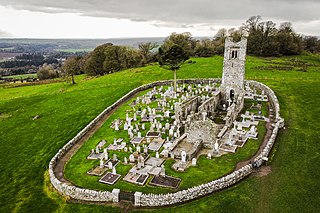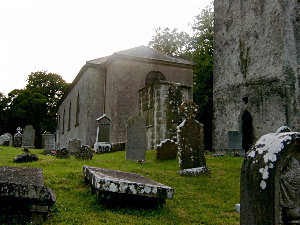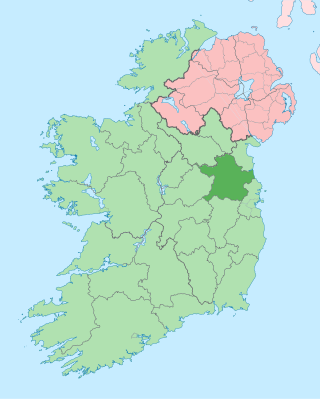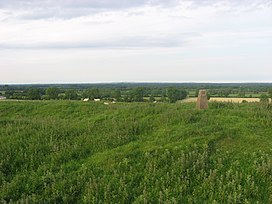
Samhain, Sauin or Oíche Shamhna is a Gaelic festival on 1 November marking the end of the harvest season and beginning of winter or "darker half" of the year. It is also the Irish language name for November. Celebrations begin on the evening of 31 October, since the Celtic day began and ended at sunset. This is about halfway between the autumnal equinox and winter solstice. It is one of the four Gaelic seasonal festivals along with Imbolc, Bealtaine, and Lughnasa. Historically it was widely observed throughout Ireland, Scotland, and the Isle of Man. A similar festival is held by the Brittonic Celtic people, called Calan Gaeaf in Wales.

Slane is a village in County Meath, in Ireland. The village stands on a steep hillside on the left bank of the River Boyne at the intersection of the N2 and the N51. As of the 2022 census, Slane's population was 1,445. The village and surrounding area contains many historic sites dating back over 5,000 years. The village centre, as it is laid-out today, dates mainly from the 18th century. The village is in a townland and civil parish of the same name.
There are four provinces of Ireland: Connacht, Leinster, Munster and Ulster. The Irish word for this territorial division, cúige, meaning "fifth part", suggests that there were once five, and at times Meath has been considered to be the fifth province. In the medieval period, however, there were often more than five. The number of provinces and their delimitation fluctuated until 1610, when they were permanently set by the English administration of James I. The provinces of Ireland no longer serve administrative or political purposes but function as historical and cultural entities.

Ardbraccan is an ancient place of worship in County Meath, Ireland. It is the location of the former residence of the Roman Catholic, then, after the Reformation, the Church of Ireland Bishop of Meath. it was also a place of prominence in pre-Christian Pagan history. It is approximately 52 km from Dublin via the M3 Motorway, and 4 km from Navan. Ardbraccan is in a civil parish of the same name.

The River Boyne is a river in Leinster, Ireland, the course of which is about 112 kilometres (70 mi) long. It rises at Trinity Well, Newberry Hall, near Carbury, County Kildare, and flows towards the Northeast through County Meath to reach the Irish Sea between Mornington, County Meath, and Baltray, County Louth.

The Hill of Tara is a hill and ancient ceremonial and burial site near Skryne in County Meath, Ireland. Tradition identifies the hill as the inauguration place and seat of the High Kings of Ireland; it also appears in Irish mythology. Tara consists of numerous monuments and earthworks—dating from the Neolithic to the Iron Age—including a passage tomb, burial mounds, round enclosures, a standing stone, and a ceremonial avenue. There is also a church and graveyard on the hill. Tara forms part of a larger ancient landscape and Tara itself is a protected national monument under the care of the Office of Public Works, an agency of the Irish Government.

County Meath is a county in the Eastern and Midland Region of Ireland, within the province of Leinster. It is bordered by County Dublin to the southeast, Louth to the northeast, Kildare to the south, Offaly to the southwest, Westmeath to the west, Cavan to the northwest, and Monaghan to the north. To the east, Meath also borders the Irish Sea along a narrow strip between the rivers Boyne and Delvin, giving it the second shortest coastline of any county. Meath County Council is the local authority for the county.

Trim Castle is a castle on the south bank of the River Boyne in Trim, County Meath, Ireland, with an area of 30,000 m2. Over a period of 30 years, it was built by Hugh de Lacy and his son Walter as the caput of the Lordship of Meath. The Irish Government currently own and are in charge of the care of the castle, through the state agency The Office of Public Works (OPW).
Túathal Techtmar, son of Fíachu Finnolach, was a High King of Ireland, according to medieval Irish legend and historical tradition. He is said to be the ancestor of the Uí Néill and Connachta dynasties through his grandson Conn of the Hundred Battles. The name may also have originally referred to an eponymous deity, possibly even a local version of the Gaulish Toutatis.

The Mound of the Hostages is an ancient passage tomb located in the Tara-Skryne Valley in County Meath, Leinster, Ireland.
Mongfind is a figure from Irish legend. She is said to have been the wife, of apparent Munster origins, of the legendary High King Eochaid Mugmedón and mother of his eldest three sons, Brión, Ailill and Fiachrae, ancestors of the historical Connachta. She was Eochaid's first wife; his second wife, Cairenn, gave birth to Niall of the Nine Hostages. Several tales depict Mongfind as an adversary of Niall. Mongfind is also said to have been the sister of Crimthann mac Fidaig, King of Munster and the next High King of Ireland, whom she is said to have killed with poison in a bid to make her son king. She drank the poisoned drink to convince Crimthann, and died soon after at Samhain.
Mug Ruith is a figure in Irish mythology, a powerful blind druid of Munster who lived on Valentia Island, County Kerry. He could grow to enormous size, and his breath caused storms and turned men to stone. He wore a hornless bull-hide and a bird mask, and flew in a ship called the roth rámach, the "oared wheel". He had a fiery ox-driven chariot with blazing jewels that made night seem as bright as day, a star-speckled black shield with a silver rim, and a stone which could turn into a poisonous eel when thrown in water.
Toirdhealbhach Mór Ua Conchobhair anglicised Turlough Mór O'Conor, was King of Connacht (1106–1156) and High King of Ireland.
Tlachtga was a powerful druidess in Irish mythology and the red-haired daughter of the arch-druid Mug Ruith. She accompanied him on his world travels, learning his magical secrets and discovering sacred stones in Italy. Tlachtga's name was attached to the Hill of Ward in County Meath, which was the site of prominent festivals in her honour in the Middle Ages.

Meath was a kingdom in Ireland from the 1st to the 12th century AD. Its name means "middle," denoting its location in the middle of the island.

The Hill of Uisneach or Ushnagh is a hill and ancient ceremonial site in the barony of Rathconrath in County Westmeath, Ireland. It is a protected national monument. It consists of numerous monuments and earthworks—prehistoric and medieval—including a probable megalithic tomb, burial mounds, enclosures, standing stones, holy wells and a medieval road. Uisneach is near the geographical centre of Ireland, and in Irish mythology it is deemed to be the symbolic and sacred centre of the island. It was said to be the burial place of the mythical Tuatha Dé Danann, and a place of assembly associated with the druids and the festival of Bealtaine.
Athboy is a small agricultural town located in County Meath. The town is located on the Yellow Ford River, in wooded country near the County Westmeath border. It is around 15 km west of Navan and 50 km north-west of Dublin. The town is in a civil parish of the same name.

Clonard Abbey was an early medieval monastery situated on the River Boyne in Clonard, County Meath, Ireland.
An aonach or óenach was an ancient Irish public national assembly called upon the death of a king, queen, or notable sage or warrior as part of ancestor worship practices. As well as the entertainment, the óenach was an occasion on which kings and notables met under truce and where laws were pronounced and confirmed.
Many neo-pagan religions such as Wicca, Druidry and Celtic Polytheism have active followings in Ireland, although the number of declared adherents is likely quite small. It has been claimed to be the fastest growing religion in Ireland.













